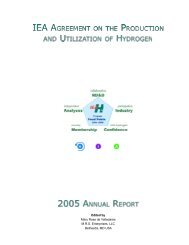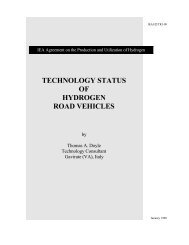Review of Small Stationary Reformers for Hydrogen Production
Review of Small Stationary Reformers for Hydrogen Production
Review of Small Stationary Reformers for Hydrogen Production
You also want an ePaper? Increase the reach of your titles
YUMPU automatically turns print PDFs into web optimized ePapers that Google loves.
Catalytic cracking <strong>of</strong> other hydrocarbons has been investigated by researchers at Gerhard-<br />
Mercator-Universitat at Duisburg, Germany (Ledjeff-Hey et al. 1998, Kalk et al. 2000). Frequent<br />
regeneration <strong>of</strong> the catalyst is required to remove accumulated carbon, but relatively low capital<br />
costs are projected because <strong>of</strong> the system’s simplicity.<br />
G. Novel Re<strong>for</strong>mer Technologies<br />
1. Sorbent Enhanced Re<strong>for</strong>ming<br />
Recently several authors have investigated the possibility <strong>of</strong> sorbent enhanced steam methane<br />
re<strong>for</strong>ming (Lyon 1996, Sircar 1996, Han and Harrison 1994, Hufton et al. 2000). Here, an<br />
absorbent (such as calcium oxide) is mixed with the steam re<strong>for</strong>ming catalyst, removing the CO<br />
and CO2 as the steam re<strong>for</strong>ming reaction progresses. The resulting syngas has a substantially<br />
higher fraction <strong>of</strong> hydrogen than that produced in a catalytic steam-re<strong>for</strong>ming reactor. A syngas<br />
composition was recently reported <strong>of</strong> 90% H2, 10%CH4, 0.5% CO2 and 700 o C) and have high oxygen flux<br />
and selectivity. These are known as ion transport membranes (ITM). Conceptual designs were<br />
carried out <strong>for</strong> a hydrogen-refueling station dispensing 0.5 million scf/day <strong>of</strong> 5000 psi hydrogen,<br />
following work by Directed Technologies, Inc. Initial estimates show the potential <strong>for</strong> a significant<br />
reduction in the cost <strong>of</strong> high pressure H2 produced via this route at the 0.1 to 1.0 million scf/day<br />
size. For example, compared to trucked-in liquid hydrogen, the ITM route <strong>of</strong>fers a 27% cost<br />
savings.<br />
Oxygen can be separated from air fed to one side <strong>of</strong> the membrane at ambient pressure or<br />
moderate pressure (1-5 psig) and reacted on the other surface with methane and steam at<br />
higher pressure (100-500 psig) to <strong>for</strong>m a mixture <strong>of</strong> H2 and CO. This can then be processed to<br />
make hydrogen or liquid fuels.<br />
Various configurations <strong>for</strong> the ITM reactor were examined, and a flat-plate system was chosen<br />
because it reduced the number <strong>of</strong> ceramic-metal seals needed.<br />
An independent ef<strong>for</strong>t to develop oxygen transport membranes is ongoing at Praxair in<br />
conjunction with the Oxygen Transport Membrane Syngas Alliance (BP Amoco, Statoil, Sasol)<br />
(see membrane reactor steam re<strong>for</strong>ming section above).<br />
19













